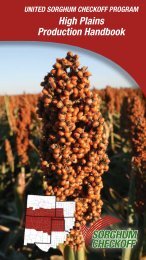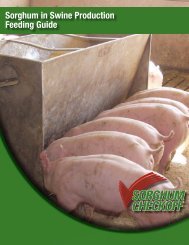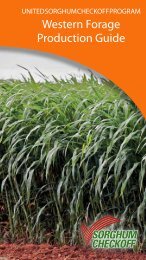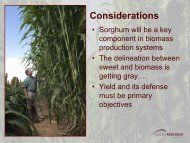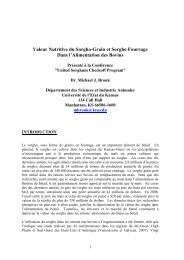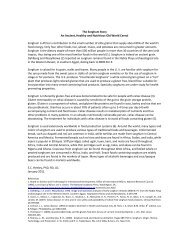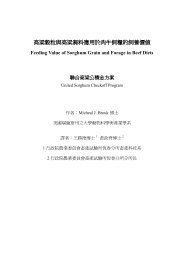Sorghum in Poultry Production Feeding Guide - Sorghum Checkoff
Sorghum in Poultry Production Feeding Guide - Sorghum Checkoff
Sorghum in Poultry Production Feeding Guide - Sorghum Checkoff
You also want an ePaper? Increase the reach of your titles
YUMPU automatically turns print PDFs into web optimized ePapers that Google loves.
Process<strong>in</strong>g of <strong>Sorghum</strong><br />
mixture of pect<strong>in</strong>ases, a-glucanases and hemicellulases to sorghum-soy feed rations<br />
for broilers, and found that ileal am<strong>in</strong>o acid digestibility <strong>in</strong>creased 3% while the ME<br />
was <strong>in</strong>creased by over 6% when used <strong>in</strong> rations that were marg<strong>in</strong>al <strong>in</strong> nutrients (16).<br />
This demonstrates that enzymes can be used to get more nutrients from sorghum.<br />
Cadogan, et al., (17) tested phytase enzyme preps on sorghum based diets and<br />
determ<strong>in</strong>ed that the enzyme improved weight ga<strong>in</strong>, am<strong>in</strong>o acid digestibility, starch<br />
digestibility and performance of broilers. Limited studies do <strong>in</strong>dicate that there are<br />
opportunities to use enzyme preparations to improve bird performance. However, the<br />
database is currently lagg<strong>in</strong>g beh<strong>in</strong>d similar studies for wheat, barley and corn.<br />
Process<strong>in</strong>g Gra<strong>in</strong> <strong>Sorghum</strong> for <strong>Poultry</strong> Feed<br />
The physical and chemical effects of heat, steam or moisture, pressure, and gr<strong>in</strong>d<strong>in</strong>g<br />
are known to <strong>in</strong>fluence digestibility of feed gra<strong>in</strong>s, <strong>in</strong>clud<strong>in</strong>g sorghum. Broiler and turkey<br />
feeds are fed <strong>in</strong> pelleted form, which results <strong>in</strong> improved weight ga<strong>in</strong> and feed efficiency<br />
regardless of the type of feed gra<strong>in</strong> used. Virtually 100% of meat bird rations<br />
<strong>in</strong> the U.S. are pelleted. Some researchers have <strong>in</strong>dicated that it may be possible to<br />
process sorghum <strong>in</strong> such a way to improve the availability of nutrients to a greater<br />
extent than other gra<strong>in</strong>s. Thus particle size, process<strong>in</strong>g time, pellet<strong>in</strong>g method, etc.,<br />
may all have an effect on the feed<strong>in</strong>g value of corn.<br />
The number of recent <strong>in</strong>vestigations that exam<strong>in</strong>e the effect of mill<strong>in</strong>g gra<strong>in</strong> sorghum<br />
and mak<strong>in</strong>g feed have been limited. Because more corn is used than sorghum <strong>in</strong> pelleted<br />
feeds, manufacturers have a large amount of experience with corn process<strong>in</strong>g<br />
relative to sorghum process<strong>in</strong>g <strong>in</strong> the poultry <strong>in</strong>dustry.<br />
Feed manufactures must consider the cost associated not only with nutritional<br />
changes, but also with the changes that may be necessary to handle and prepare<br />
a particular <strong>in</strong>gredient. Storage or identity preservation, gr<strong>in</strong>d<strong>in</strong>g requirements and<br />
mill through put are just some of the factors that must be considered when handl<strong>in</strong>g<br />
an additional gra<strong>in</strong>. Sav<strong>in</strong>g money on basic nutrients that will only be lost dur<strong>in</strong>g the<br />
manufactur<strong>in</strong>g process is not a wise decision.<br />
“...it may be<br />
possible to<br />
process<br />
sorghum <strong>in</strong><br />
such a way to<br />
improve the<br />
availability of<br />
nutrients...”<br />
Experienced feed manufacturers will agree that feeds with added sorghum are more<br />
difficult to pellet. This is partly due to the slightly lowered energy value of feed that is<br />
sometimes balanced <strong>in</strong> the ration with additional oil or fat which is known to reduce<br />
pellet quality. Adjustments <strong>in</strong> retention time, temperatures, etc., may be necessary<br />
to reach desired pellet quality. However, manufactures should be cautioned when<br />
extensively process<strong>in</strong>g gra<strong>in</strong> sorghum. Recent work from Selle, et al. <strong>in</strong> 2010 (11)<br />
summarized data from other researchers that concludes sorghum could be vulnerable<br />
to moist heat that <strong>in</strong>duces undesirable chemical cross l<strong>in</strong>k<strong>in</strong>g <strong>in</strong> karaf<strong>in</strong> prote<strong>in</strong>s,<br />
which reduces nutritional quality. It is not known if studies that implicated cross-l<strong>in</strong>ks<br />
between some prote<strong>in</strong>s and the starch <strong>in</strong> sorghum (Rooney and Pflugfelder, 1986)<br />
(12, 15) are affected by process<strong>in</strong>g conditions. Studies that attempted to restructure<br />
the sorghum prote<strong>in</strong>s with methods like expansion showed that, although expansion<br />
greatly improved the f<strong>in</strong>al pellet quality of sorghum based rations, the <strong>in</strong>creased pellet<br />
9



